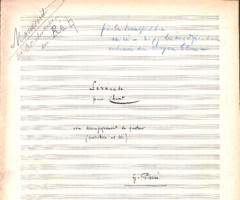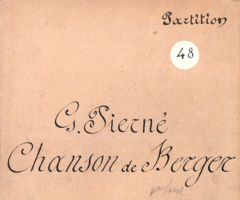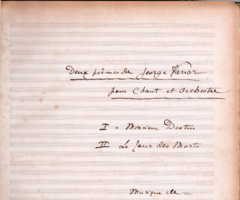The French Mélodie with orchestra
If you want to have your Lieder with orchestra, don’t think twice, the Lied with orchestra is a social necessity; if there were such a thing, singers in concerts would not always be performing operatic arias, which often create such a mediocre impression”. (Camille Saint-Saëns)
Certain geniuses are like lighthouses whose powerful beams occasionally dazzle those they are supposed to guide. When it comes to the French mélodie or art song, the masterpieces by Fauré, Duparc, Chausson, Debussy and Ravel sometimes seem to have appeared out of the blue like some miracle of spontaneous generation. However, if we focus only on these pinnacles of achievement, we would be ignoring a whole century of French thought and dispute on the subject of the mélodie, and particularly the mélodie with orchestral accompaniment: from the orchestrated romances of the early 19th century, and the first forays into the form by Hector Berlioz (Les Nuits d’été), Félicien David, and Saint-Saëns, to the famed golden age of song at the turn of the new century. Saint-Saëns wrote to Marie Jaëll in 1876: “If you want to have your Lieder with orchestra, don’t think twice, the Lied with orchestra is a social necessity; if there were such a thing, singers in concerts would not always be performing operatic arias, which often create such a mediocre impression”. Apart from battling against the overwhelming predominance of opera arias in concert programmes, this artistic endeavour also became a political fight: the aim was to overhaul the Ars gallica (music by French composers) at a time when German art was taking Europe by storm. Particularly close attention was paid to the orchestration of the mélodie in the French school. The “orchestral colour” was placed in the service of the poem, which was generally regarded as superior to the music: it was supposed to allow the composer to fit the lines of verse over the melody “like a jeweller sets a gem”. As a result, two schools sprang up at the same time: that of the “miniaturists” with their sparing orchestration (Massenet, Dubois, Saint-Saëns, etc.) and that of the symphonists, who were more ambitious in their sound (Duparc, Jaëll, Lili Boulanger, etc.).
Videos
Related persons
Related works
Les Barques
Florent SCHMITT
/Robert de MONTESQUIOU
Chansons écossaises
Émile PALADILHE
/Charles-Marie LECONTE DE LISLE
La Fiancée du timbalier
Camille SAINT-SAËNS
/Victor HUGO
Lied maritime op. 43
Vincent d' INDY
Les Nuits d’été
Hector BERLIOZ
/Théophile GAUTIER
Poëmes chantés
Gustave CHARPENTIER
/Jean-Louis de BALZAC Charles BAUDELAIRE Émile BLÉMONT Camille MAUCLAIR Joseph MÉRY Lucien PUECH Georges VANOR Paul VERLAINE
La Procession
César FRANCK
/Auguste BRIZEUX
Shéhérazade
Maurice RAVEL
/Tristan KLINGSOR
Documents and archives
Permalink
publication date : 19/10/23
Back to the list of Focus



